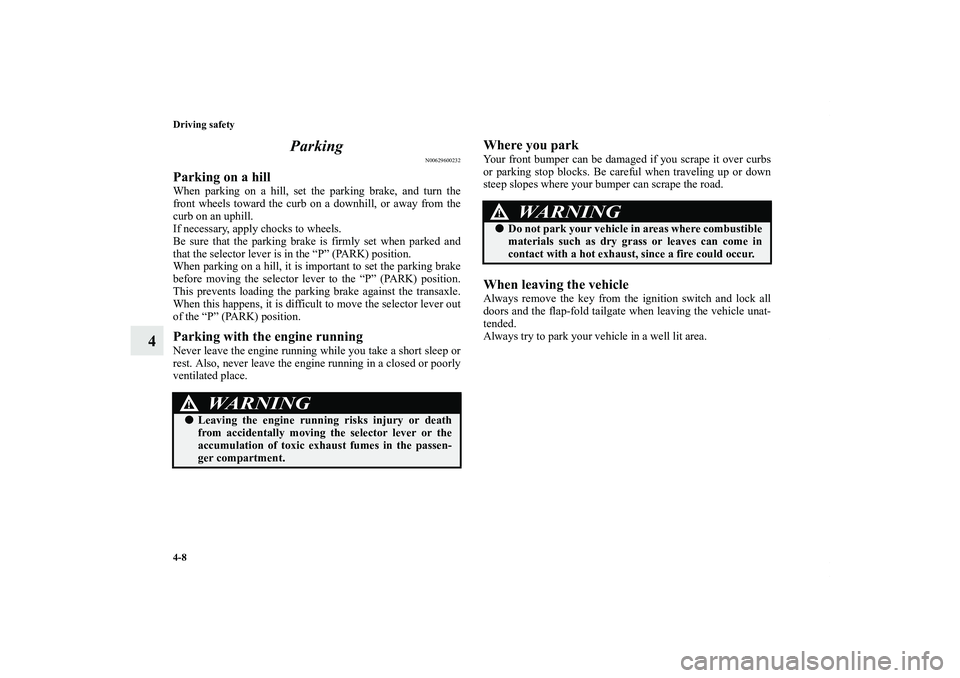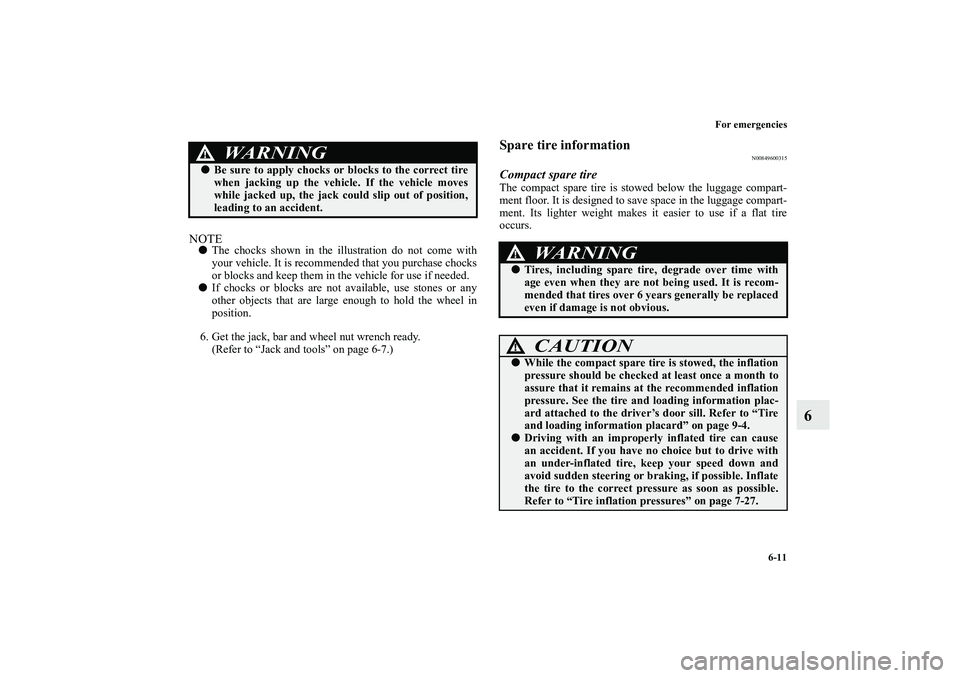Page 415 of 714

4-8 Driving safety
4Parking
N00629600232
Parking on a hillWhen parking on a hill, set the parking brake, and turn the
front wheels toward the curb on a downhill, or away from the
curb on an uphill.
If necessary, apply chocks to wheels.
Be sure that the parking brake is firmly set when parked and
that the selector lever is in the “P” (PARK) position.
When parking on a hill, it is important to set the parking brake
before moving the selector lever to the “P” (PARK) position.
This prevents loading the parking brake against the transaxle.
When this happens, it is difficult to move the selector lever out
of the “P” (PARK) position.Parking with the engine runningNever leave the engine running while you take a short sleep or
rest. Also, never leave the engine running in a closed or poorly
ventilated place.
Where you parkYour front bumper can be damaged if you scrape it over curbs
or parking stop blocks. Be careful when traveling up or down
steep slopes where your bumper can scrape the road.When leaving the vehicleAlways remove the key from the ignition switch and lock all
doors and the flap-fold tailgate when leaving the vehicle unat-
tended.
Always try to park your vehicle in a well lit area.
WA R N I N G
!�Leaving the engine running risks injury or death
from accidentally moving the selector lever or the
accumulation of toxic exhaust fumes in the passen-
ger compartment.
WA R N I N G
!�Do not park your vehicle in areas where combustible
materials such as dry grass or leaves can come in
contact with a hot exhaust, since a fire could occur.
BK0138000US.book 8 ページ 2011年4月13日 水曜日 午前11時17分
Page 420 of 714

Driving safety
4-13
4 Cargo loads
N00629700435
Cargo load precautions
N00630300040
To determine the cargo load capacity for your vehicle, subtract
the weight of all vehicle occupants from the vehicle capacity
weight. For additional information, if needed, refer to “Steps
for Determining Correct Load Limit” on page 4-11.
DO NOT USE the Gross Vehicle Weight Rating and Gross
Axle Weight Rating numbers listed on the safety certification
label (A) located on the inside sill of the driver’s door as the
guide for passengers and/or cargo weight.
WA R N I N G
!�To reduce the risk of serious injury or death, the
combined weights of the driver, passengers and
cargo and must never exceed the vehicle capacity
weight.�Exceeding the vehicle capacity weight will adversely
affect vehicle performance, including handling and
braking, and may cause an accident.�Do not load cargo or luggage higher than the top of
the seatback. Be sure that your cargo or luggage
cannot move when your vehicle is in motion.
Having either the rear view blocked, or your cargo
being thrown inside the cabin if you suddenly have
to brake can cause a serious accident or injury or
death.�Put cargo or luggage in the cargo area of your vehi-
cle. Try to spread the weight evenly.
BK0138000US.book 13 ページ 2011年4月13日 水曜日 午前11時17分
Page 584 of 714

For emergencies
6-11
6
NOTE�The chocks shown in the illustration do not come with
your vehicle. It is recommended that you purchase chocks
or blocks and keep them in the vehicle for use if needed.
�If chocks or blocks are not available, use stones or any
other objects that are large enough to hold the wheel in
position.
6. Get the jack, bar and wheel nut wrench ready.
(Refer to “Jack and tools” on page 6-7.)
Spare tire information
N00849600315
Compact spare tireThe compact spare tire is stowed below the luggage compart-
ment floor. It is designed to save space in the luggage compart-
ment. Its lighter weight makes it easier to use if a flat tire
occurs.
WA R N I N G
!�Be sure to apply chocks or blocks to the correct tire
when jacking up the vehicle. If the vehicle moves
while jacked up, the jack could slip out of position,
leading to an accident.
WA R N I N G
!�Tires, including spare tire, degrade over time with
age even when they are not being used. It is recom-
mended that tires over 6 years generally be replaced
even if damage is not obvious.
CAUTION
!�While the compact spare tire is stowed, the inflation
pressure should be checked at least once a month to
assure that it remains at the recommended inflation
pressure. See the tire and loading information plac-
ard attached to the driver’s door sill. Refer to “Tire
and loading information placard” on page 9-4.�Driving with an improperly inflated tire can cause
an accident. If you have no choice but to drive with
an under-inflated tire, keep your speed down and
avoid sudden steering or braking, if possible. Inflate
the tire to the correct pressure as soon as possible.
Refer to “Tire inflation pressures” on page 7-27.
BK0138000US.book 11 ページ 2011年4月13日 水曜日 午前11時17分
Page 605 of 714
7-4 Vehicle care and maintenance
7Engine hood
N00937500507
To openUse the engine hood release lever (located under the instrument
panel near the driver’s door) to unlock the engine hood.
Pull the lever toward you to release the engine hood latch.Release the lever and lift the engine hood.
NOTE�To prevent damage to the engine hood and wipers, make
sure the wipers are at resting position when you open the
engine hood.
WA R N I N G
!�Never use the release lever to unlatch the engine
hood while the vehicle is in motion.�Do not drive your vehicle unless the engine hood is
locked.
BK0138000US.book 4 ページ 2011年4月13日 水曜日 午前11時17分
Page 644 of 714
Vehicle care and maintenance
7-43
7
*: Fusible link
�Some fuses may not be installed on your vehicle, depend-
ing on the vehicle model or specifications.
�The table above shows the main equipment corresponding
to each fuse.
No.
Symbol
Electrical system
Capacity
1 Heater 30 A*
2Stop lights
(Brake lights)15 A
3 Rear fog light 10 A
4 Windshield wiper 30 A
5 Optional 10 A
6 Door locks 20 A
7Radio15 A
8 Control unit relay 7.5 A
9Interior lights
(Dome lights)15 A
10 Hazard warning flasher 15 A
11 Rear window wiper 15 A
12 Gauges 7.5 A
13Cigarette lighter
/Accessory socket15 A
14Ignition
Switch10 A
15 Sunroof 20 A
16 Outside rearview mirrors 10 A
17 All-wheel drive system 10 A
18 Back-up lights 7.5 A
19 Accessory socket 15 A
20 Power window control 30 A*
21 Defogger 30 A*
22 Heated door mirror 7.5 A
23 115V Power Outlet 15 A
24 Power seats 25 (20) A
25 Heated seats 30 ANo.
Symbol
Electrical system
Capacity
BK0138000US.book 43 ページ 2011年4月13日 水曜日 午前11時17分
Page 707 of 714

Alphabetical index
2Power brakes 3-129
Service brake 3-128
Warning lights 3-210
Break-in recommendations 3-2
Bulb capacity 7-49
C
California Perchlorate Materials Requirements 1-9
Capacities 9-11
Card holder 3-270
Cargo area cover 3-287
Cargo loads 4-13
Cargo room light
Bulb capacity 7-51
Replacement 7-75
Catalytic converter 7-3
Cautions on the handling of all-wheel drive vehicles 3-126
Certification label 9-5
Charging system warning light 3-212
Child restraint systems 2-50
Child safety locks for rear door 3-59
Cleaning
Inside of your vehicle 7-79
Outside of your vehicle 7-81
Clock 5-136
Coat hook 3-290
Consumer information 8-2
Continuously variable transmission (CVT) 3-104
Fluid 7-18
,9-11Selector lever operation 3-104
Selector lever positions 3-109
Sports mode 3-110
Coolant (engine) 7-12
,9-11
Cruise control 3-142
Cup holder 3-283
D
Daytime running lights
Bulb capacity 7-49
Replacement 7-56
Defogger (rear window) 3-236
Defrosting or defogging (windshield, door windows) 5-14
,5-
23
,5-33
,5-43
Dimensions 9-6
Dimmer (high/low beam change) 3-220
Disc brake pads 7-37
Dome light
Bulb capacity 7-51
Replacement 7-73
,7-75
Doors
Lock 3-53
Power door locks 3-57
Driving during cold weather 4-6
Driving precaution 4-2
Driving, alcohol and drugs 4-3
E
Electric rear window defogger switch 3-236
BK0138000US.book 2 ページ 2011年4月13日 水曜日 午前11時17分